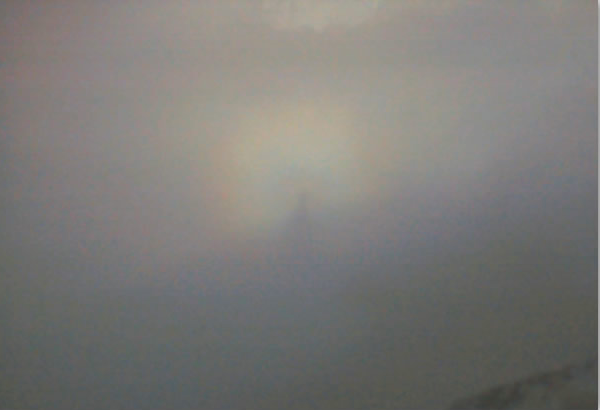Pic du Midi moonlight glory
Pic du Midi Moonlight Glory: A Spectacular Atmospheric Optics Phenomenon
When it comes to atmospheric optics, the Pic du Midi Observatory in the French Pyrenees never fails to amaze. In a recent observing session at the 60cm telescope, André Rondi, Sylvain Rondi, and Bruno David captured an extraordinary phenomenon known as "moonlight glory." This ethereal apparition, even more ghostly than ordinary glories and Brocken spectres, appeared high up in the night sky. Let's delve into the details of this captivating event and explore the science behind it.
To capture this elusive sight, the photographers employed a Nikon D70 camera with a 30mm lens and a wide aperture setting of f/1.4. With a 30-second exposure, they were able to freeze the moment and reveal the intricate details of the moonlight glory. The result is a mesmerizing image that showcases the beauty and complexity of atmospheric optics.
So, what exactly is a moonlight glory? This enchanting phenomenon occurs when moonlight interacts with tiny water droplets or ice crystals suspended in the air. The droplets act as miniature lenses, refracting and reflecting the moonlight in a unique way. As a result, a circular halo of light is formed around the observer's shadow, creating a stunning display of colors and patterns.
Moonlight glories are particularly captivating because they are often larger and more vivid than their daytime counterparts. The absence of direct sunlight allows for greater visibility and enhances the contrast between the glory and its surroundings. This makes moonlight glories a rare treat for those lucky enough to witness them.
The location of the Pic du Midi Observatory adds an extra layer of mystique to this already extraordinary event. Situated at an elevation of 2,877 meters (9,439 feet), the observatory offers an unparalleled vantage point above the clouds. The clear mountain air and the absence of light pollution make it an ideal setting for observing atmospheric phenomena.
To fully appreciate the intricacies of a moonlight glory, it is important to understand the science behind it. The phenomenon occurs due to a combination of diffraction, refraction, and reflection of light. As moonlight passes through the droplets or ice crystals, it undergoes these optical processes, resulting in the formation of the circular halo.
The size and shape of the droplets or crystals play a crucial role in determining the characteristics of the moonlight glory. Smaller droplets tend to produce smaller glories, while larger droplets can create more expansive and vibrant displays. The shape of the droplets also influences the appearance of the glory, with spherical droplets producing circular glories and irregularly shaped droplets leading to distorted or elongated glories.
The colors observed within a moonlight glory are a result of interference and diffraction of light waves. The light waves interfere with each other, leading to constructive and destructive interference patterns. These patterns give rise to the concentric rings of colors that are characteristic of glories. The exact colors seen can vary depending on factors such as the size and composition of the droplets, as well as the angle of observation.
In conclusion, the Pic du Midi Observatory's moonlight glory is a truly mesmerizing atmospheric optics phenomenon. Captured by talented photographers, this ethereal apparition showcases the beauty and complexity of nature's light show. With its unique location and optimal viewing conditions, the observatory offers a front-row seat to witness such captivating events. So, keep your eyes on the sky and be prepared to be amazed by the wonders of atmospheric optics.

If 'ordinary' glories and Brocken spectres are ghostly, this one is doubly so.
It was produced by moonlight high up at the Pic du Midi Observatory in the French Pyrenees.
André Rondi, Sylvain Rondi and Bruno David captured the apparition after an observing session at the 60cm telescope.
It was not easy to see. The image was obtained with a 30s exposure at f/1.4 using a 30mm lens on a Nikon D70.
©André Rondi, Sylvain Rondi and Bruno David.
Note: this article has been automatically converted from the old site and may not appear as intended. You can find the original article here.
Reference Atmospheric Optics
If you use any of the definitions, information, or data presented on Atmospheric Optics, please copy the link or reference below to properly credit us as the reference source. Thank you!
-
<a href="https://atoptics.co.uk/blog/pic-du-midi-moonlight-glory/">Pic du Midi moonlight glory</a>
-
"Pic du Midi moonlight glory". Atmospheric Optics. Accessed on November 26, 2024. https://atoptics.co.uk/blog/pic-du-midi-moonlight-glory/.
-
"Pic du Midi moonlight glory". Atmospheric Optics, https://atoptics.co.uk/blog/pic-du-midi-moonlight-glory/. Accessed 26 November, 2024
-
Pic du Midi moonlight glory. Atmospheric Optics. Retrieved from https://atoptics.co.uk/blog/pic-du-midi-moonlight-glory/.